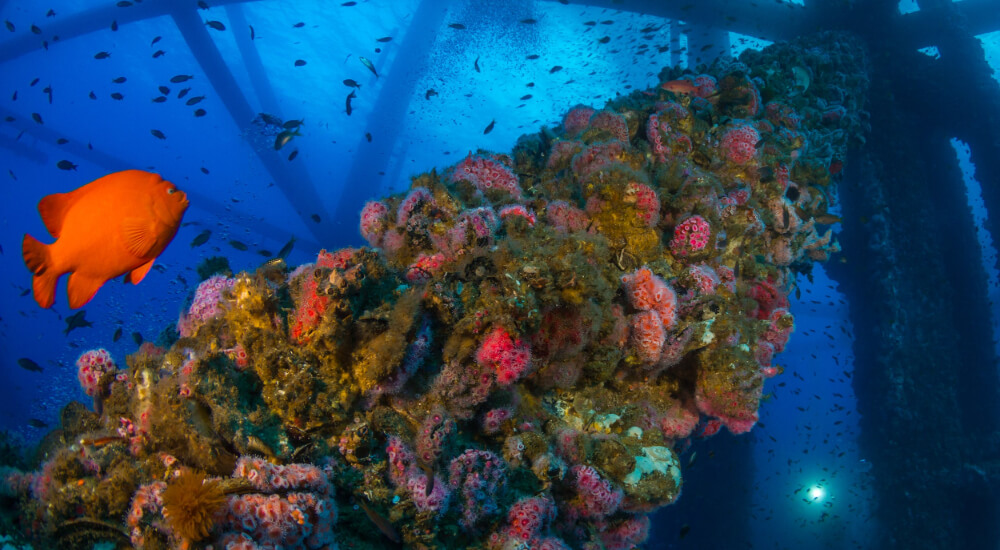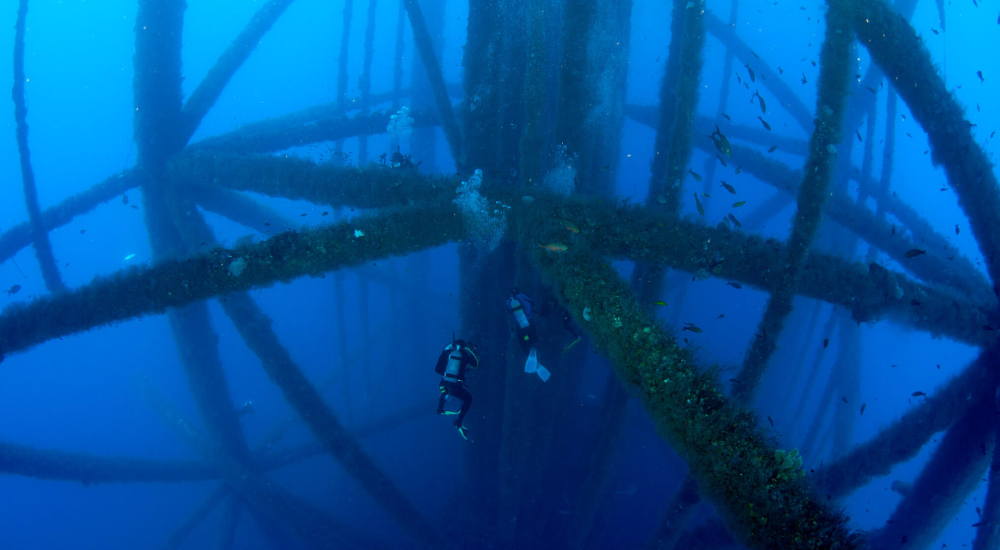Thousands of oil rigs pierce the surface of the water throughout the world. Some are still functional and drilling for oil, while others have been abandoned or partially removed. Oil rigs may not look like much above the surface, but underwater they provide some amazing photographic opportunities. These massive metal structures provide habitat to an abundance of marine life, which is also part of the reason why oil rigs have become such popular destinations for scuba divers in search of something else than natural reefs.
The Need for Artificial Reefs
At least half of the oxygen produced on Earth comes from the ocean. We cannot survive without healthy oceans yet ocean acidification threatens to disturb the ecological balance that produces what we need to survive. Corals, zooplankton, algae, shellfish, and other organisms cannot adapt to the rapid increase in acidity.
Over the past several decades, we have lost more than 30% of the Earth’s coral reefs. According to scientists, by 2052 we could lose 90% of the coral reefs due to acidification and other forms of pollutions, as well as overfishing. Such a scenario would have terrible ecological and economic consequences.
How Rig Ecosystems Could Help Address Environmental Issues
Artificial reefs such as former oil rigs can be reconfigured to cultivate a limestone substrate on which coral can grow. The corrosion protection systems used on these metal structures have been found to cause the growth of limestone. The limestone growth process coupled with processes that can accelerate the growth of coral could potentially help grow coral reefs faster than they are dying off.
When oil rigs become obsolete, they require removal under environmental regulations, a financially demanding effort that requires sophisticated machinery and can cause a significant disturbance to the underlying ecosystems. Researchers believe turning oil rigs into reefs is a less expensive and less environmentally costly method of retiring and repurposing these metal structures.
Rigs-to-Reefs throughout the World

The unlikely place where life thrives.
Photo: Joe Platko
According to a study from researchers at the Aarhus University in Denmark, partial removal of the platforms is considered to deliver better environmental outcomes than complete removal. In the late-twentieth century, Denmark destroyed important marine habitats, including the breeding grounds for fish, through underwater mining. This ecosystem collapse has pushed the nation to think of ways to rebuild its underwater reefs.
The oil and gas platforms in the North Sea seem to be an ideal solution to this pressing problem. The underwater cameras installed on these structures showed thriving marine communities living on and around them. But these findings are in no way limited only to the North Sea. Rigs to reefs movements have had great success in other parts of the world like the United States, Malaysia, and Saudi Arabia.
The United States was among the first nations to see the ecological potential of oil rigs. The first planned Rigs-to-Reefs conversion took place in Florida in 1979 with the relocation of a subsea template from offshore Louisiana to a site off Florida. In 1984, the United States Congress signed the National Fishing Enhancement Act which provided the basis for artificial reef programs.
There are more than 4,000 oil production platforms in the United States portion of the Gulf of Mexico, the largest concentration of offshore platforms in the world. By 2000, over 150 oil platforms in the Gulf had been converted to permanent artificial reefs. As of now, it is estimated that more than 500 rigs have been turned into reefs in the outlying parts of the United States.
Popular Diveable Oil Rig Reefs
High Island 389A, Texas, United States
The High Island 389A is an eight-leg production platform that was installed in 1981 just outside the designated No Activity Zone for oil and gas production in East Flower Garden Bank. When the Flower Garden Banks National Marine Sanctuary was designated in 1992, the platform fell inside the sanctuary boundaries.
Despite this, it continued to produce until 2012 and in 2014, the oil company initiated negotiations for the platform to be established as an artificial reef as part of the Texas Parks & Wildlife Rigs-To-Reefs program. Removal of the top portion of the platform and the deck was completed in 2018.
Today, the High Island 389A is recognized as one of the best artificial reefs in the northern Gulf of Mexico. The platform sits at a depth of 125 meters (410 feet) and displays a wide ecosystem of animals that range from critters such as tessellated blennies and barnacles to pelagics like silky sharks and whale sharks.
Eureka Oil Platform, California, United States
Platform Eureka sits in federal waters off the coast of Long Beach. Lying on the sea bottom at 220 meters (720 feet), it is the deepest diver-accessible oil rig in the world. The massive structure is home to many Californian species such as sea lions, garibaldis, blacksmiths, and more. The little creatures can be seen here too – nudibranchs, crabs, brittle stars, and scallops adorn the metal structure.
Nearby are the twin rigs of Ellen and Elly, a double platform with a bridge connecting them. They are a lot shallower than Eureka but still sit in about 80 meters (260 feet) of water, well beyond recreational diving. Diving these rigs is an amazing experience especially on days with great visibility. All three platforms are still in use.
Seaventures Dive Rig, Sabah, Malaysia
Maintaining the look of a working oil platform, the Seaventures Dive Rig is now a unique five-star dive resort located near Sipadan and Kapalai Islands. It sits atop its own house reef and offers 360-degree views of the islands. Divers gear up in a dive station and then take an external elevator that allows them to slide directly into the water or into the waiting dive boat beneath the platform. Guests can go on diving excursions across the region, including to the famous Sipadan.
In addition to being a reclaimed oil rig, the resort is committed to conservation and sustainability and offers classes to educate guests on the importance of preserving the delicate reef ecosystems. Being in one of the top diving destinations in the world and enjoying premier facilities in a one-of-a-kind setting sure sounds great, doesn’t it?
Baram-8, Sarawak, Malaysia
Located in the South China Sea, Baram-8 is one of the best examples of how leaving an oil rig in place can have a significant impact on the marine ecosystem. The oil platform was installed in 1968 offshore from Tanjung Baram, Miri. It collapsed in 1975 and was turned into an artificial reef in 2004 after being cut into two sections and moved to a shallower site at a maximum depth of 21 meters (69 feet).
Only three months after its relocation, Reef Check Malaysia found large schools of juvenile jacks, large groupers, snappers, bannerfish, batfish, fusiliers, damselfish, angelfish, and sweetlips thriving around the platform. The high diversity of marine life and accessible depth have attracted the local scuba divers and Baram-8 is now a popular dive site.
Not everyone agrees with the concept of rigs-to-reefs, with some individuals believing this practice may encourage “ocean dumping,” creating a loophole that could allow companies to dump obsolete machinery into the sea. Despite such potential drawbacks, researchers believe that with the right regulations, leaving these artificial reefs in place could in fact help the ocean heal from human intervention.
What’s your take on rigs-to-reefs? Leave us a comment below.

